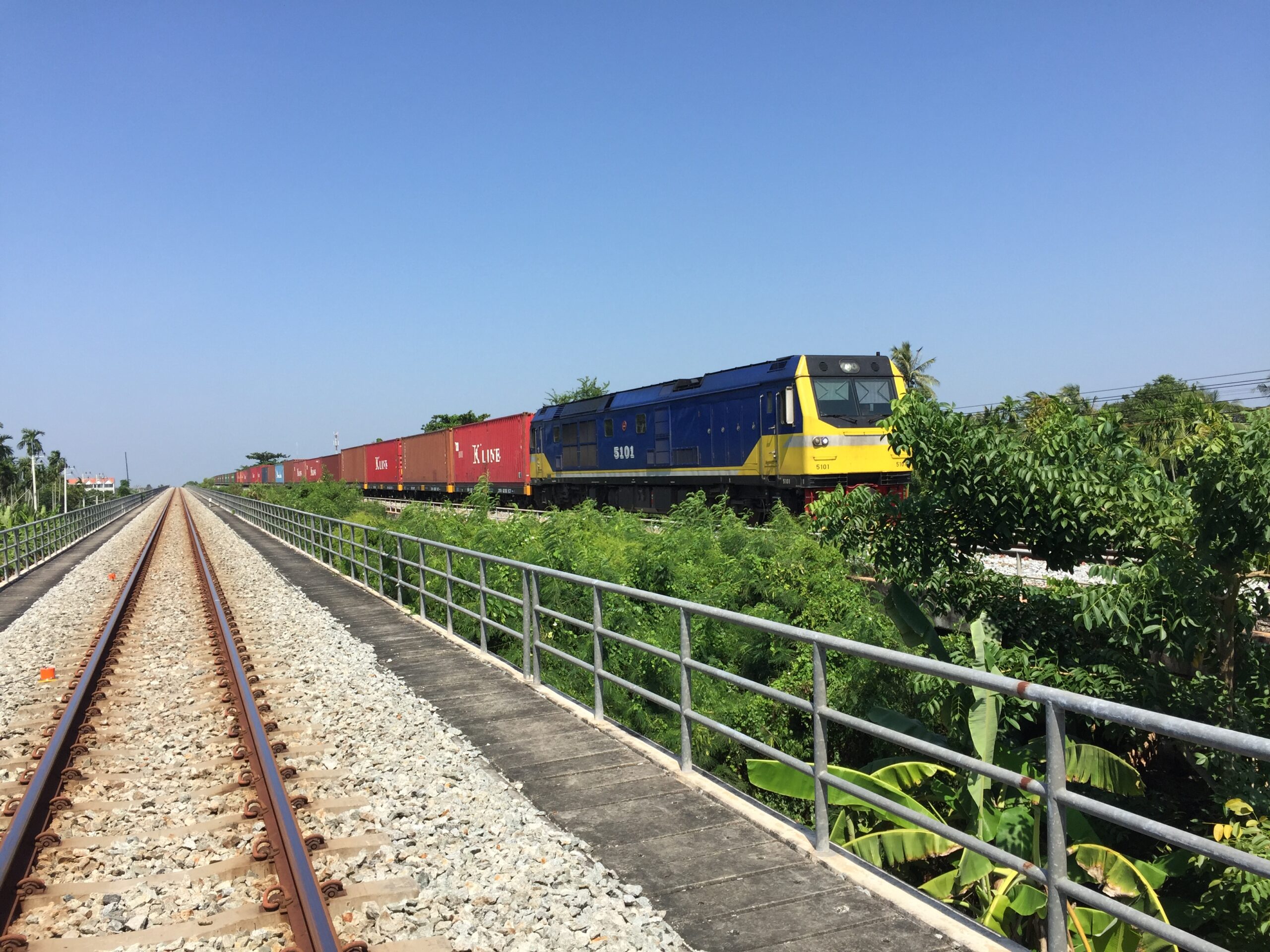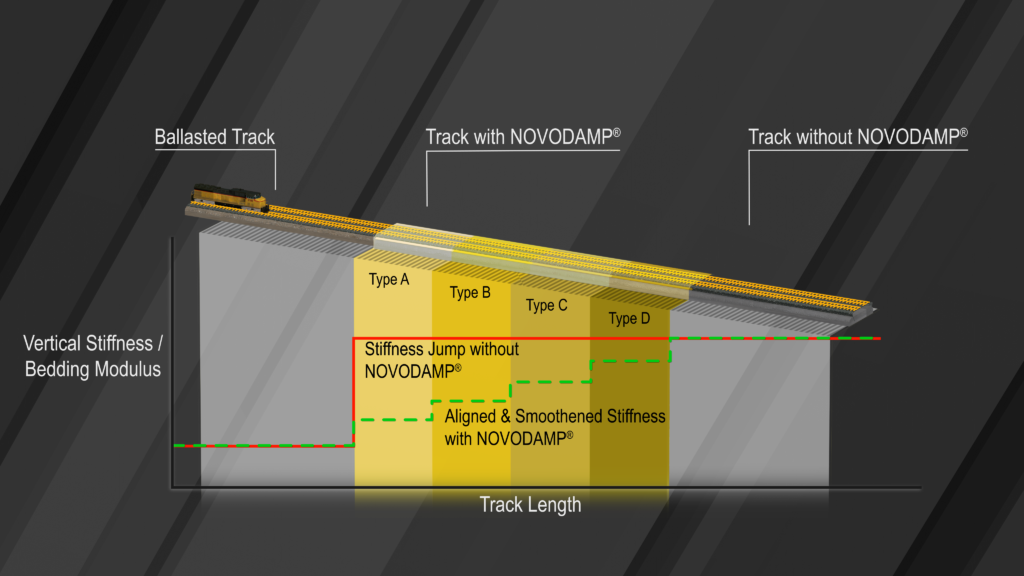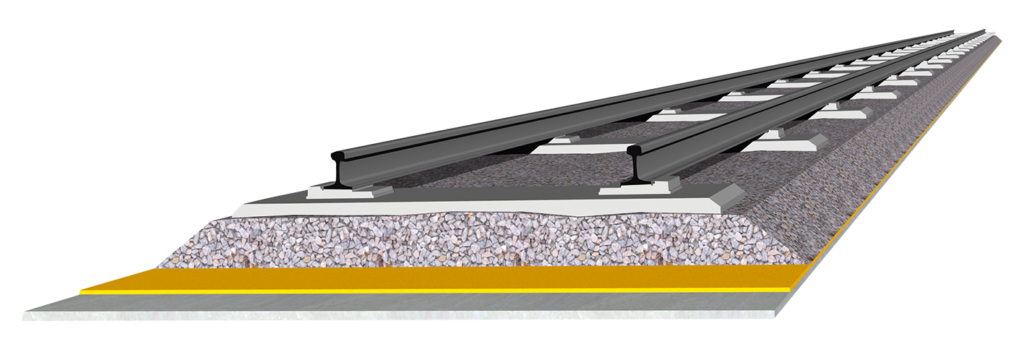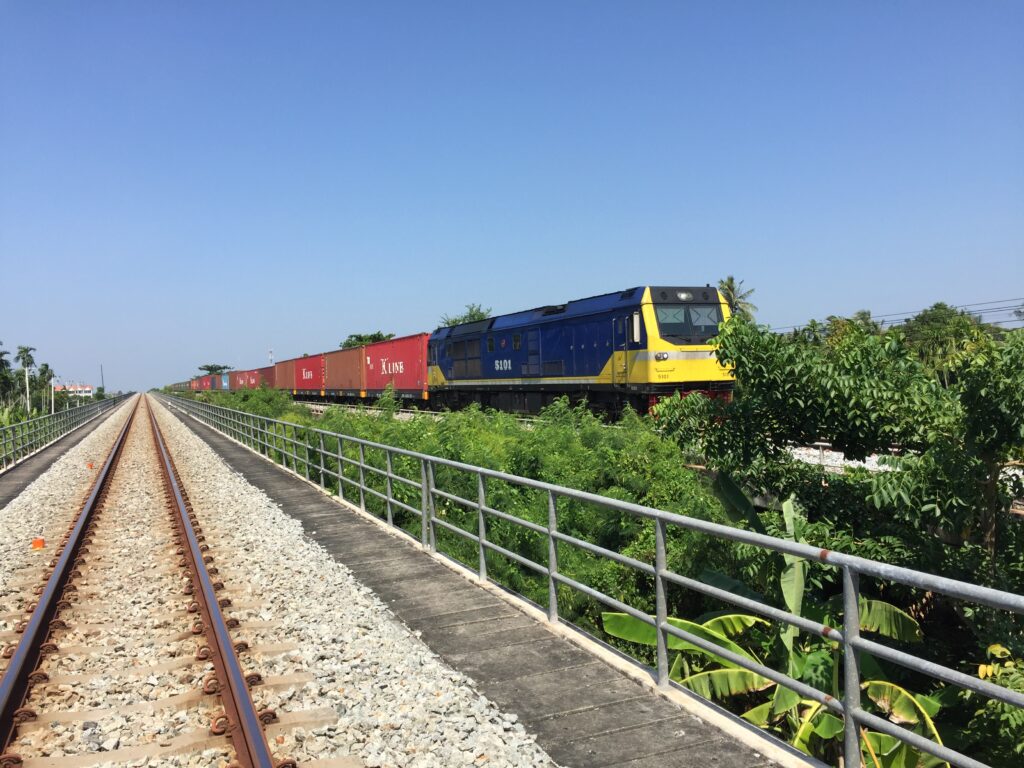info@gerb.com
Ballasted track at Stiffness Transition Zones
Providing elasticity at stiffness transition zones between concrete bridge and approach slab
Within a comprehensive infrastructure development program, a railway company expanded their single railway network to a double track. The trains run on single, non-electrified tracks with a gauge of 1,000 mm and connects destinations with an expansive rail network of 4,000 km. With the objective to implement a maintenance-free and sustainable upgrade, GERB provided an elasticity solution that reduced all deleterious effects at the transition between concrete bridges and approached slabs.

Challenge
One remarkable feature of this railway network is the great number of bridges and high associated maintenance costs observed at transition zones between the free track and bridge. Generally, the main reasons for the high maintenance costs are settlement of the soil at the embankment and track due the sudden change of elasticity at the transition zone. The bedding modulus or vertical stiffness of the concrete bridge is 6 times higher than the supporting structure of the free track.
Various attempts at mitigating the problem were developed, including soil compaction, and approach slabs on treated ground, even pile foundations were implemented. These measures successfully reduced track settlement, but did not address the required stiffness adjustment of the transition zone.
Solution
GERB proposed a smooth stiffness transition zone with closed-cell polyurethane mats as described in DIN EN 16432. The principle is to compensate for the sudden jump in stiffness between approach slab soil and concrete support structure. Thereby, a smoother transition of the stiffness between the free track and the bridge results in smaller differential vertical displacements during train vehicle transit.
GERB resolves this stiffness disparity by placing full surface NOVODAMP® Under Ballast Mats. These closed-cell polyurethane pads rest on the bridge under the ballast as shown (figure left) and they harmonize the stiffness at transitions zone of railway superstructures.

Based on the given soil parameter and specific site conditions GERB provides bespoke solutions. NOVODAMP® closed-cell polyurethane mats are designed and tested to meet rigorous international standards. They are available in different stiffness and thickness variants to accommodate project demands. In this case a required length of 22 m with two different types of polyurethane mats were designed based on a given train speed of 160 km/h.
NOVODAMP® mats are also easy and fast to install. They are simply placed directly on the bridge before the ballast is placed over the mats. This leads to very low installation costs and minimal downtime compared with other methods to reduce maintenance cost.

Result
Field measurements were performed to investigate the effectiveness of the GERB NOVODAMPER® stiffness modification in the critical transition zone between bridge structure and approach slab. Deflections at several defined positions were measured to determine the vertical stiffness of the track before and after mat installation.
By analyzing the measurement data, a smoothening of the stiffness jump could be proven after the installation of NOVODAMP® full-surface under ballast mats.
The stiffness jump factor between bridge and approach slab was determined as follows:
BEFORE Installation: 2.5 to 4.8
AFTER Installation: 0.7 to 1.1
The test results have shown an overall reduction of the stiffness jump by at least factor 3 in this project. Furthermore these results and the effectiveness of the GERB NOVODAMP® solution were witnessed by the operator and an independent observer, a local University.

Further Resources
You need further information on this topic?
Please do not hesitate to contact us with your individual question.
One of our project engineers will get back to you shortly.
Ballasted track at Stiffness Transition Zones
Providing elasticity at stiffness transition zones between concrete bridge and approach slab
Within a comprehensive infrastructure development program, a railway company expanded their single railway network to a double track. The trains run on single, non-electrified tracks with a gauge of 1,000 mm and connects destinations on a total extension of 4,000 km. With the objective to implement a maintenance-free and sustainable upgrade, GERB provided an elasticity solution that reduced all deleterious effects at the transition between concrete bridges and approached slabs.

Ballasted track at Stiffness Transition Zones
Providing elasticity at stiffness transition zones between concrete bridge and approach slab
Within a comprehensive infrastructure development program, a railway company expanded their single railway network to a double track. The trains run on single, non-electrified tracks with a gauge of 1,000 mm and connects destinations on a total extension of 4,000 km. With the objective to implement a maintenance-free and sustainable upgrade, GERB provided an elasticity solution that reduced all deleterious effects at the transition between concrete bridges and approached slabs.

Challenge
One remarkable feature of this railway network is the great number of bridges and high associated maintenance costs observed at transition zones between the free track and bridge. Generally, the main reasons for the high maintenance costs are settlement of the soil at the embankment and track due the sudden change of elasticity at the transition zone. The bedding modulus or vertical stiffness of the concrete bridge is 6 times higher than the supporting structure of the free track.
Various attempts at mitigating the problem were developed, including soil compaction, and approach slabs on treated ground, even pile foundations were implemented. These measures successfully reduced track settlement, but did not address the required stiffness adjustment of the transition zone.
Challenge
One remarkable feature of this railway network is the great number of bridges and high associated maintenance costs observed at transition zones between the free track and bridge. Generally, the main reasons for the high maintenance costs are settlement of the soil at the embankment and track due the sudden change of elasticity at the transition zone. The bedding modulus or vertical stiffness of the concrete bridge is 6 times higher than the supporting structure of the free track.
Various attempts at mitigating the problem were developed, including soil compaction, and approach slabs on treated ground, even pile foundations were implemented. These measures successfully reduced track settlement, but did not address the required stiffness adjustment of the transition zone.
Solution
GERB proposed a smooth stiffness transition zone with closed-cell polyurethane mats as described in DIN EN 16432. The principle is to compensate for the sudden jump in stiffness between approach slab soil and concrete support structure. Thereby, a smoother transition of the stiffness between the free track and the bridge results in smaller differential vertical displacements during train vehicle transit.
GERB resolves this stiffness disparity by placing full surface NOVODAMP® Under Ballast Mats. These closed-cell polyurethane pads rest on the bridge under the ballast as shown (figure left) and they harmonize the stiffness at transitions zone of railway superstructures.

Based on the given soil parameter and specific site conditions GERB provides bespoke solutions. NOVODAMP® closed-cell polyurethane mats are designed and tested to meet rigorous international standards. They are available in different stiffness and thickness variants to accommodate project demands. In this case a required length of 22 m with two different types of polyurethane mats were designed based on a given train speed of 160 km/h.
NOVODAMP® mats are also easy and fast to install. They are simply placed directly on the bridge before the ballast is placed over the mats. This leads to very low installation costs and minimal downtime compared with other methods to reduce maintenance cost.

Solution
GERB proposed a smooth stiffness transition zone with closed-cell polyurethane mats as described in DIN EN 16432. The principle is to compensate for the sudden jump in stiffness between approach slab soil and concrete support structure. Thereby, a smoother transition of the stiffness between the free track and the bridge results in smaller differential vertical displacements during train vehicle transit.
GERB resolves this stiffness disparity by placing full surface NOVODAMP® Under Ballast Mats. These closed-cell polyurethane pads rest on the bridge under the ballast as shown (figure left) and they harmonize the stiffness at transitions zone of railway superstructures.

Based on the given soil parameter and specific site conditions GERB provides bespoke solutions. NOVODAMP® closed-cell polyurethane mats are designed and tested to meet rigorous international standards. They are available in different stiffness and thickness variants to accommodate project demands. In this case a required length of 22 m with two different types of polyurethane mats were designed based on a given train speed of 160 km/h.
NOVODAMP® mats are also easy and fast to install. They are simply placed directly on the bridge before the ballast is placed over the mats. This leads to very low installation costs and minimal downtime compared with other methods to reduce maintenance cost.

Result
Field measurements were performed to investigate the effectiveness of the GERB NOVODAMPER® stiffness modification in the critical transition zone between bridge structure and approach slab. Deflections at several defined positions were measured to determine the vertical stiffness of the track before and after mat installation.
By analyzing the measurement data, a smoothening of the stiffness jump could be proven after the installation of NOVODAMP® full-surface under ballast mats.
The stiffness jump factor between bridge and approach slab was determined as follows:
BEFORE Installation: 2.5 to 4.8
AFTER Installation: 0.7 to 1.1
The test results have shown an overall reduction of the stiffness jump by at least factor 3 in this project. Furthermore these results and the effectiveness of the GERB NOVODAMP® solution were witnessed by the operator and an independent observer, a local University.

Result
Field measurements were performed to investigate the effectiveness of the GERB NOVODAMPER® stiffness modification in the critical transition zone between bridge structure and approach slab. Deflections at several defined positions were measured to determine the vertical stiffness of the track before and after mat installation.
By analyzing the measurement data, a smoothening of the stiffness jump could be proven after the installation of NOVODAMP® full-surface under ballast mats.
The stiffness jump factor between bridge and approach slab was determined as follows:
BEFORE Installation: 2.5 to 4.8
AFTER Installation: 0.7 to 1.1
The test results have shown an overall reduction of the stiffness jump by at least factor 3 in this project. Furthermore these results and the effectiveness of the GERB NOVODAMP® solution were witnessed by the operator and an independent observer, a local University.

Share this post
Further Resources
You need further information on this topic?
Please do not hesitate to contact us with your individual question.
One of our project engineers will get back to you shortly.
Further Resources
You need further information on this topic?
Please do not hesitate to contact us with your individual question.
One of our project engineers will get back to you shortly.